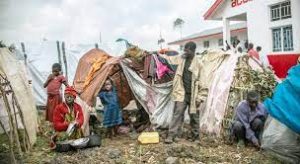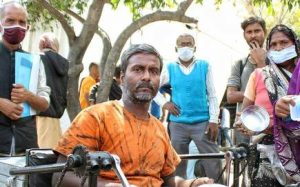Today Current Affairs: 6th December 2022 for UPSC IAS exams, State PSC exams, SSC CGL, State SSC, RRB, Railways, Banking Exam & IBPS, etc
Table of Contents
Social Hostilities Index:

India tops the index on social hostilities relating to religion.
- The report was released by the Washington-based think tank Pew Research Centre
- The SHI measures acts of religious hostility by private individuals, organizations or groups.
- The index comprises 13 metrics, including religion-related armed conflict or terrorism and mob or sectarian violence.
- At 9.4 out of a maximum possible score of 10, India’s Social Hostilities Index (SHI) in 2020 was worse than neighbouring Pakistan and Afghanistan.
National Commission For Backward Classes:

The 102nd Constitutional Amendment Act, 2018, NCBC became a constitutional body, established under Article 338B of the Indian Constitution.
- Hansraj Ahir assumes charge as NCBC chairperson.
- The commission was the outcome of the Indra Sawhney case (1992) and was a statutory body.
- The Chairperson, Vice-Chairperson and other Members of the Commission shall be appointed by the President
- The conditions of service and tenure of office shall be decided by President.
Kaziranga Project:

India and France are collaborating on Kaziranga Project.
- Agence Française de Développement (AFD) of France has committed funding of €80.2 million for a 10-year period, between 2014-2024.
- The Kaziranga project is a part of a larger Assam Project on Forest and Biodiversity Conservation (APFBC).
- The Assam government, with the support of AFD, launched the APFBC in 2012, to restore forest ecosystems, protect wildlife and enhance the livelihood of the forest-dependent communities.
- The project conceptualised the reforestation of 33,500 hectares of land and the training of 10,000 community members in alternate livelihoods by 2024.
Kaziranga National Park:
- It is located in the State of Assam and covers 42,996 Hectare (ha).
- It is the single largest undisturbed and representative area in the Brahmaputra Valley floodplain.
- It was declared as a National Park in 1974.
- It has been declared a tiger reserve since 2007. It has a total tiger reserve area of 1,030 sq km with a core area of 430 sq. km.
- It was declared a UNESCO World Heritage Site in 1985.
Report On Forced Displacement: UNDP

According to the United Nations Development Program (UNDP) report “Turning the tide on internal displacement: A development approach to solutions”, for the first time ever, more than 100 million people were forcibly displaced in 2022, most of them within their own countries.
Findings of the Report:
- At the end of 2021, there were over 59 million people forcibly displaced within their own countries due to conflict, violence, disasters and climate change.
- Before the war in Ukraine, 6.5 million people are estimated to have been internally displaced.
- By 2050, climate change may force more than an estimated 216 million people to move within their own countries.
- Disaster-related internal displacement is even more widespread, with new displacements recorded in over 130 countries and territories in 2021.
- Around 30% of professional lives became unemployed and 24% were not able to earn money the same way as before.
- 48% of the internally displaced households earned less money than before displacement.
Food And Agriculture Organization’s (FAO) Report:

According to the Food and Agriculture Organization’s (FAO) new report, The Future of Food and Agriculture — Drivers and triggers for transformation, the world will witness persistent food insecurity if agrifood systems remain the same.
- This report aims at inspiring strategic thinking and actions to transform agrifood systems towards a sustainable, resilient and inclusive future.
Findings of the Report:
- There are 18 interconnected socio-economic and environmental forces, called drivers, which interacted and shaped the various activities occurring within agrifood systems, including farming, food processing, and food consumption.
- Poverty and inequalities, geopolitical instability, scarcity and the degradation of resources, and climate change are some of the key drivers and how they are and their management will determine what the future of food looks like.
- The world will witness persistent food insecurity, degrading resources and unsustainable economic growth in the future if agrifood systems remain the same.
- The world is “tremendously off track” to meet the Sustainable Development Goals (SDG), including agrifood targets.
- Many of the SDGs are not on track and will only be achieved if agrifood systems are transformed properly to withstand ongoing global adversity that undermines food security and nutrition due to growing structural inequalities and also regional inequalities.
- By 2050, there will be 10 billion people in the world to feed and this will be an unprecedented challenge if significant attempts are not made to reverse current trends.
Global Report On Health Equity For Disables:

Ahead of the International Day of Persons with Disabilities (3rd December), the World Health Organization (WHO) has released a report titled- Global report on health equity for persons with disabilities.
Findings of the Report:
- Currently, some 1.3 billion people, or one in six, worldwide suffer from major disabilities.
- Because of the systemic and persistent health inequities, many persons with disabilities face the risk of dying much earlier even up to 20 years earlier—than persons without disabilities.
- An estimated 80 % of people with disabilities reside in low- and middle-income countries with limited resources, making it difficult to address these inequities.
- They are at a two-fold risk of contracting chronic illnesses like asthma, depression, diabetes, obesity, dental disorders and stroke.
- Many of the discrepancies in health outcomes cannot be attributed to underlying health conditions but rather to preventable, unfair and unjust circumstances.
Mount Semeru Volcano Eruption:

Mount Semeru volcano erupted recently triggering top alert status.
- It is located in Indonesia.
- It is one of the East Java Island’s tallest volcano.
- Semeru’s last major eruption was in December 2021.
- Semeru, also known as Mahameru, has erupted numerous times in the past 200 years.
- Indonesia is one of the most disaster-prone nations on earth.
- Pacific “Ring of Fire”: It is a horseshoe-shaped series of fault lines, and is prone to earthquakes and volcanic activity.
- With 142 volcanoes, Indonesia has the largest population globally living in close range to a volcano, including 8.6 million within 10km (6.2 miles)
International Civil Aviation Organisation Ranking:

India is among the top 50 countries with best aviation safety in the latest ICAO rankings.
- In the rankings by the ICAO, India is now at the 48th position, a “quantum leap” from the 102nd rank it had in 2018.
- The rankings are for 187 countries and assessments were done at different points of time.
- Under its Universal Safety Oversight Audit Programme (USOAP) Continuous Monitoring Approach, an ICAO Coordinated Validation Mission (ICVM) was undertaken from November 9 to 16.
- The rankings are topped by Singapore with a score of 99.69 per cent. It is followed by the UAE at the second position and the Republic of Korea is at the third place.
- With a score of 49 per cent each, India and Georgia are at the 48th position. Neighbouring Pakistan is at the 100th spot with a score of 70.39 per cent.
ICAO:
- ICAO is funded and directed by 193 national governments to support their diplomacy and cooperation in air transport as signatory states to the Chicago Convention (1944).
- ‘Chicago Convention’ established the core principles permitting international transport by air, and led to the creation of the specialized agency which has overseen it ever since – the International Civil Aviation Organization (ICAO).
- ICAO develops standards for global air transport and assists its 192 Member States in sharing the world’s skies to their socio-economic benefit.
- Headquarters: Montreal, Canada
First Loss Default Guarantee (FLDG) System: RBI

Two months after the Reserve Bank issued guidelines on digital lending, banks, NBFCs and fintech players are still awaiting clarity on many aspects, including the FLDG system.
- FLDG is a lending model between a fintech and a regulated entity in which a third party guarantees to compensate up to a certain percentage of default in a loan portfolio of the regulated entities (RE).
- Under these agreements, the fintech originates a loan and promises to compensate the partners up to a pre-decided percentage in case customers fail to repay.
- The bank/NBFC partners lend through the fintech but from their own books.
- FLDG helps expand the customer base of traditional lenders but relies on the fintech’s underwriting capabilities.
- A report by an RBI-constituted working group on digital lending has laid down risks of FLDG agreements with unregulated entities. The other concern is that FLDG costs are often passed on to customers.




